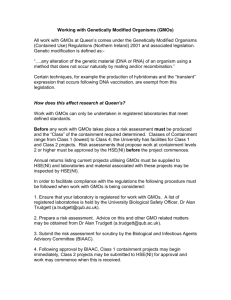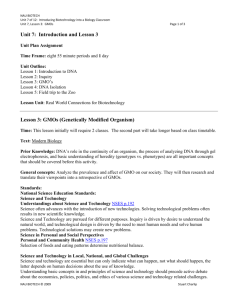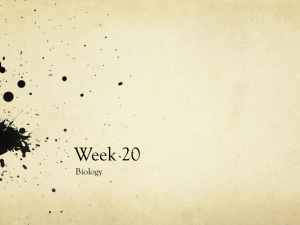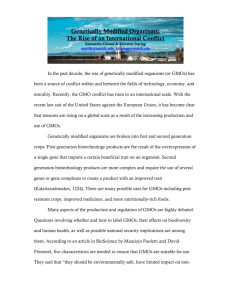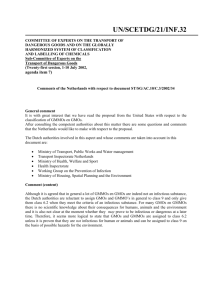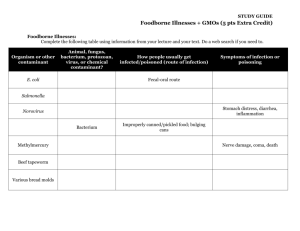TARGETING CAPITAL: INDUSTRY STRUCTURES AND THE
advertisement
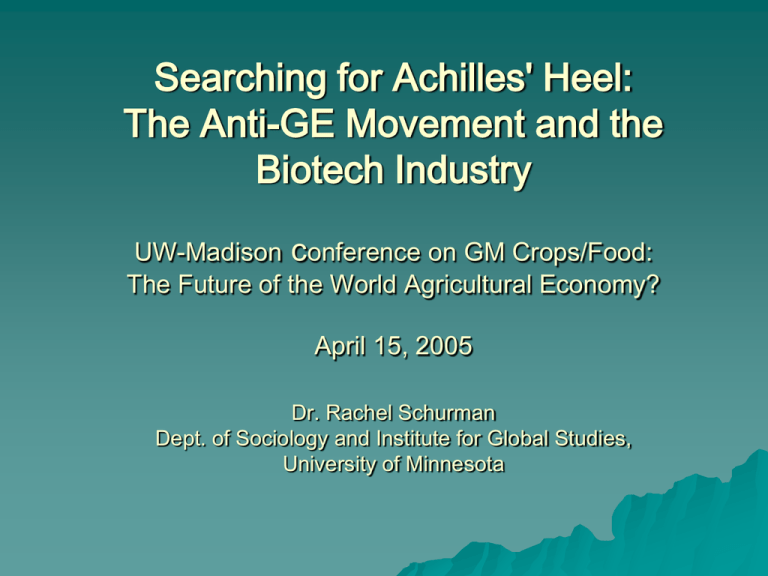
Searching for Achilles' Heel: The Anti-GE Movement and the Biotech Industry UW-Madison conference on GM Crops/Food: The Future of the World Agricultural Economy? April 15, 2005 Dr. Rachel Schurman Dept. of Sociology and Institute for Global Studies, University of Minnesota Goal: To explain the turnaround in the ag biotech industry’s fortunes in the late 1990s, and in particular, its rejection in Europe Basic premise: Organized activism was responsible for changing the industry's fortunes... Reasoning: – No major public health disasters with GMOs – No corporate scandals – The “counterfactual”… (what would have happened w/o activism) Cover of Newsweek, 1999 Evidence of the problem: ♦ June 1998: Monsanto invests $5 million in ad campaign to convince Europeans of GMOs’ benefits. ♦ Nov. 1999: 7 large life sciences firms form new industry alliance to improve public image in the US (BIO) ♦ Early 2000: firms narrow R&D to focus on 4 major crops. Become less ‘bullish’ toward technology. ♦ 1999-2002: Major industry restructuring. Three LS firms put ag divisions up for sale. Venture K flows dry up. What happened? Argument: Three factors conjointly explained the activists’ impact on the industry: – Activists’ strategic behavior, – the structural vulnerabilities of the biotech industry, deriving from “industry structures” and – the cultural and political context in Europe. Definition of industry structures (IS): The organization of an industry, the economic and institutional relationships that characterize it, and the “normal” or culturally resonant way of doing things within it Key idea: “IS” provide political openings and closures to SMs, and render firms and industries more or less vulnerable to activist challenges Strategic Behavior Public demonstrations Anti-GM “gardening” "There are moments and issues in history where parliament is inadequate and it falls to the people themselves to act. With the case of genetic engineering and the granting of patents on life, I believe we have reached one of those historic moments." -Alan Simpson MP for Nottingham Supermarket campaigns Constructed alternative frames: “Frankenstein foods”, genetic contamination, GMOs as “unnatural” products “Seize the Day” folk group targeting Monsanto Activists also worked from the inside, to pressure particular EU governments to reject GMOs. Gov’ts were more or less receptive depending on politics of the moment France and British governments became less willing to approve GMOs in the late 1990s) These activist strategies interacted with industry structures and political cultural context to turn Europe against GMOs… Several IS important: 1) Relations along supply “or commodity” chain. Biotech industry dependent on processors and retailers for a market, but not vice versa. Allowed activists to divide the corporate community; became too costly for retailers to support biotech industry, and they split... (Note difference with US, where such costs haven’t been imposed) Supply chain for the ag biotech industry Ag biotech firms (seeds) Farmers Monsanto, Dupont Processors (Nestle’s, Nabisco, Gerber) Elevators or traders (ADM, Cargill) Retailers (Safeway, Sainsbury’s, McDonalds) 2) Competitive behavior and asset structure of firms were important: Supermarket sector in Europe (esp. Britain) is a highly competitive oligopoly Activists played one firm off against another Brand names and firm reputations important - puts retailers on the defensive Iceland makes a strategic move 3) Organizational cultures played a role… Malcolm Walker, CEO of Iceland, uncomfortable with GMOs (personal values Process of “institutional isomorphism” occurs (copy cat behavior) MAJOR EUROPEAN SUPERMARKET CHAINS TO GO "GMO-FREE" (partial list) Action announced Date announced Iceland Will no longer use GM ingredients in own brand products March 18, 1998 Carrefour Will no longer use GM ingredients in own brand products February 5, 1999 ASDA Will no longer use GM ingredients in own brand products February 13, 1999 Mark's and Spencer Will no longer use GM ingredients in its products March 15, 1999 Sainsbury's Will no longer use GM ingredients in own brand products March 17, 1999 Co-op Will no longer use GM ingredients in own brand products March 18, 1999 Waitrose Will no longer use GM ingredients in own brand products March 18, 1999 Tesco Will no longer use GM ingredients in own brand products; will label all other products that contain GMOs April 27, 1999 Firm type Political-Cultural Context Cultural identities around food and agriculture Recent public health scares (“Mad cow" disease, CJ disease) Anti-imperialist sensibilities Outcomes EU wide de facto moratorium (at least until recently) Heightened awareness of the issue (GMOs) and major shift in public opinion against GMOs Strict labeling laws for GM foods, allowing consumers to discriminate Current challenges (for anti-GE movement) Need to maintain public opposition ongoing challenge Need a way to deal with the ending of the moratorium: new environment Finding a way to work with EU farmers Need to counter global winds, which are blowing in the industry’s favor again (Brazil, Monsanto’s first qtr earnings) Activist strategies Working on the co-existence issue; trying to find loopholes and openings (coexistence rules, liability) Working from ground up (grassroots groups) to build a ‘GMO-free regions’ movement Trying to strengthen labeling laws to include animal feed Seeking to maintain pressure on retailers thru ‘report card’ approach (Greenpeace) Industry strategies Also seeking to influence national coexistence rules Trying to split farmers’ interests from activists’ (e.g, reducing farmer risk by offering to purchase contaminated crops) Simply “outliving” the movement and hubbub Not clear how the conflict among these adversaries will play out, but …it is clear that this is a new moment and new terrain Possible new sources of energy for movement: 1) Pharming (plant pharmaceuticals) 2) Cloned and GE animals 3) Some other unexpected food, public health, environmental disaster

